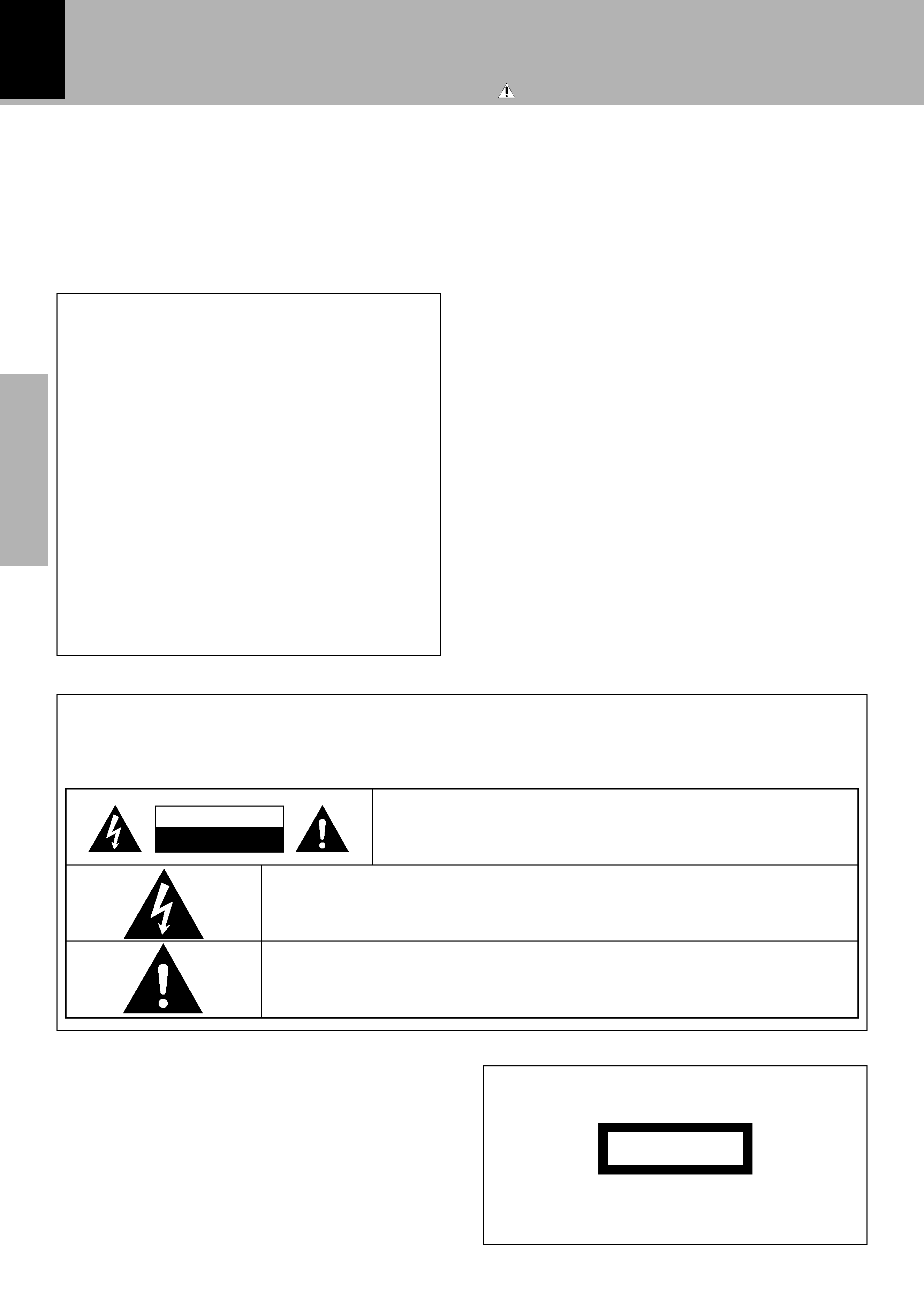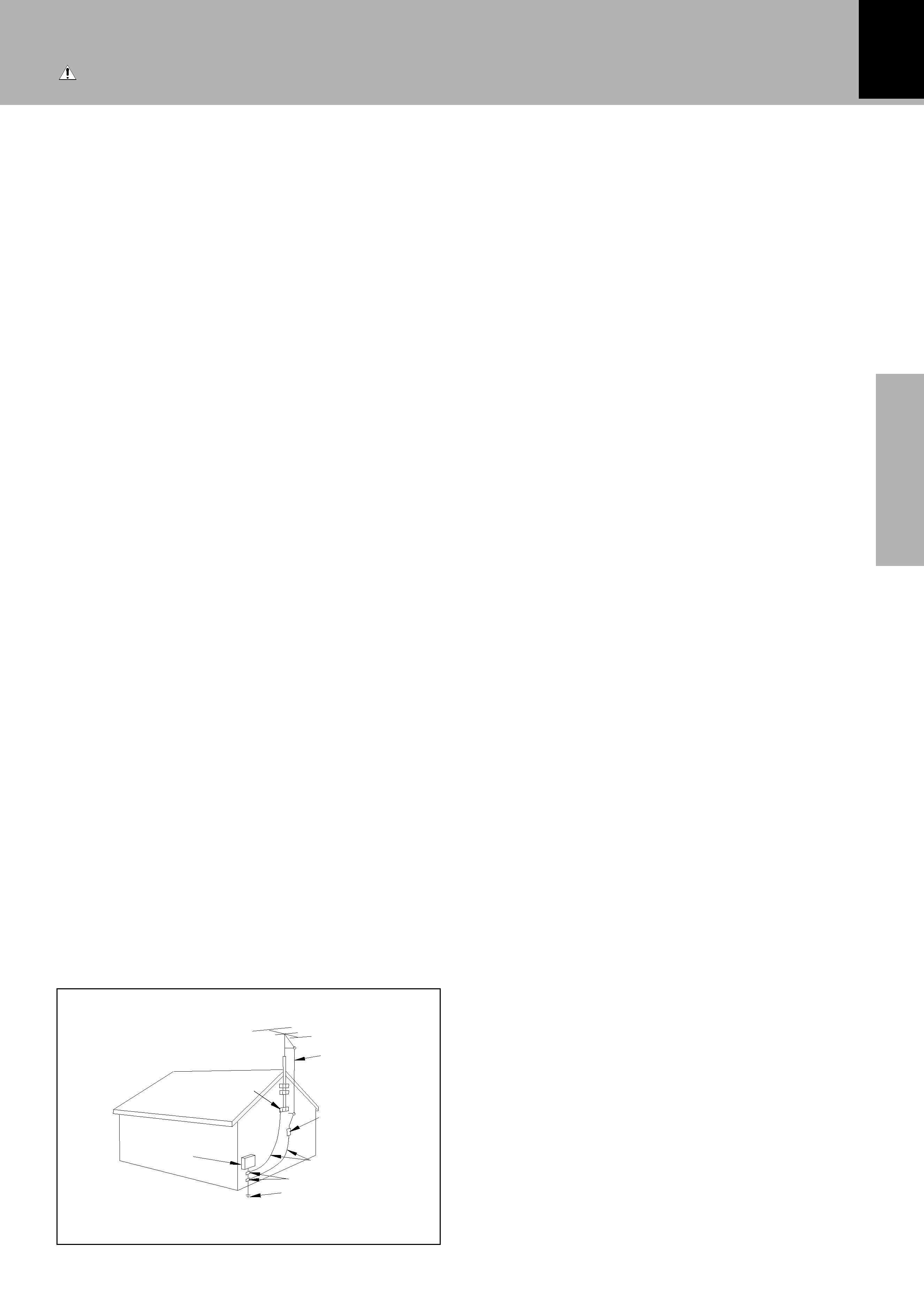
FM/AM RECEIVER
TEXT
DIGITAL AUDIO
COMPACT
INSTRUCTION MANUAL
KENWOOD CORPORATION
B60-4358-00
R-SG7
CD PLAYER
CASSETTE TAPE DECK
DP-SG7
X-SG7
EN

R-SG7/DP-SG7/X-SG7 (EN)
2
Preparation
section
Basic
section
Application
section
Knowledge
sections
Before applying power
Before applying power
Caution : Read this page carefully to ensure safe operation.
Units are designed for operation as follows.
U.S.A. and Canada ................................................................... AC 120 V only
Australia .................................................................................... AC 240 V only
The marking is located on the rear panel and says that the compo-
nent uses laser beams that have been classified as Class 1. It means
that the unit is utilizing laser beams that are of a weaker class. There
is no danger of hazardous radiation outside the unit.
CLASS 1
LASER PRODUCT
The marking of products using lasers
(Except for some areas)
For the United Kingdom
Factory fitted moulded mains plug
1.The mains plug contains a fuse. For replacement, use only a 13-
Amp ASTA-approved (BS1362) fuse.
2.The fuse cover must be refitted when replacing the fuse in the
moulded plug.
3.Do not cut off the mains plug from this equipment. If the plug
fitted is not suitable for the power points in your home or the cable
is too short to reach a power point, then obtain an appropriate
safety approved extension lead or adapter, or consult your dealer.
If nonetheless the mains plug is cut off, remove the fuse and dis-
pose of the plug immediately, to avoid a possible shock hazard by
inadvertent connection to the mains supply.
IMPORTANT: The wires in the mains lead are coloured in accord-
ance with the following code:
Blue
: Neutral
Brown : Live
Do not connect those leads to the earth terminal of a three-pin plug.
Europe and U.K. ........................................................................ AC 230 V only
China and Russia ..................................................................... AC 220 V only
*Other countries ................................ AC 110-120 / 220-240 V switchable
Safety precautions
WARNING : TO PREVENT FIRE OR ELECTRIC SHOCK, DO NOT EXPOSE THIS APPLIANCE TO
RAIN OR MOISTURE.
CAUTION: TO REDUCE THE RISK OF ELECTRIC SHOCK, DO NOT REMOVE COVER
(OR BACK). NO USER-SERVICEABLE PARTS INSIDE. REFER SERVICING TO QUALI-
FIED SERVICE PERSONNEL.
RISK OF ELECTRIC SHOCK
DO NOT OPEN
THE LIGHTNING FLASH WITH ARROWHEAD SYMBOL, WITHIN AN EQUILATERAL TRIANGLE, IS INTENDED
TO ALERT THE USER TO THE PRESENCE OF UNINSULATED "DANGEROUS VOLTAGE" WITHIN THE
PRODUCT'S ENCLOSURE THAT MAY BE OF SUFFICIENT MAGNITUDE TO CONSTITUTE A RISK OF ELEC-
TRIC SHOCK TO PERSONS.
THE EXCLAMATION POINT WITHIN AN EQUILATERAL TRIANGLE IS INTENDED TO ALERT THE USER TO
THE PRESENCE OF IMPORTANT OPERATING AND MAINTENANCE (SERVICING) INSTRUCTIONS IN THE
LITERATURE ACCOMPANYING THE APPLIANCE.
CAUTION

R-SG7/DP-SG7/X-SG7 (EN)
3
Preparation
section
Basic
section
Application
section
Knowledge
sections
Before applying power
Caution : Read the pages marked
carefully to ensure safe operation.
Contents
Preparation section
Application section
Basic section
Knowledge section
Before applying power ................................................. 2
Safety precautions .............................................................. 2
IMPORTANT SAFEGUARDS ............................................... 4
The High grade Micro Component Series ...................... 6
About the Instruction Manual ........................................... 6
Special features .................................................................. 7
System Composition and Installation ......................... 8
System connection ........................................................ 9
Antenna connection ............................................................ 9
Connection of audio cord ................................................ 10
Connection of speakers ................................................... 12
Connection of system control cord ................................ 13
Power Cord Connection ................................................... 13
Controls and indicators ............................................... 14
Main Unit ............................................................................ 14
Remote control Unit .......................................................... 16
Operation of remote control unit ............................... 17
Hearing sound ............................................................... 18
Basic use ............................................................................ 18
Playback of CD ................................................................... 20
Playback of tape ................................................................ 22
Receiving broadcast station ........................................... 26
Collective presetting of stations (auto preset) ............ 27
One-by-one presetting (manual preset) ........................ 27
Recording ...................................................................... 28
Recording ............................................................................ 28
Playback of CD ............................................................. 31
Listening in the desired sequence
(program playback) ......................................................... 31
Repeated playback ........................................................... 33
Listening to an unexpected title sequence
(random playback) ........................................................... 34
Convenient CD recording ............................................ 35
Selecting the optimum recording method ........................... 35
Giving preference to the tape length
over the tarck sequence
(time edit recording) ....................................................... 36
Recording only desired tarcks
(ONE TOUCH EDIT......single tarck recording) .................... 37
One-touch recording of an entire CD
(ONE TOUCH EDIT......recording of all tarcks) ..................... 38
R.D.S. (Radio Data System) ......................................... 39
Searching for a desired program type
(PTY search) ..................................................................... 40
To be able to listen to the desired information
at any time
(EON reservation) ............................................................ 42
Listening with high sound quality (Pure A) ............. 43
Listening in Pure A mode ................................................. 43
Clock adjustment ......................................................... 44
Timer operation ............................................................ 45
Operate easy To use Timer (O.T.T.) ................................. 45
Sleep timer ......................................................................... 45
Timer programming ........................................................... 46
Important items ............................................................. 49
Handling of discs and tapes ............................................ 49
Maintenance ...................................................................... 50
Reference ............................................................................ 51
In case of difficulty ...................................................... 52
Specifications ............................................................... 55

R-SG7/DP-SG7/X-SG7 (EN)
4
Preparation
section
Basic
section
Application
section
Knowledge
sections
Before applying power
Please read all of the safety and operating instructions
before operating this appliance. Adhere to all warnings
on the appliance and in the instruction manual. Follow all the
safety and operating instructions.
These safety and
operating instructions should be retained for future
reference.
1. Power sources The appliance should be connected
to a power supply only of the type described in the
instruction manual or as marked on the appliance. If you
are not sure of the type of power supply to your home,
consult your appliance dealer or local power company.
For appliances intended to operate from battery power,
or other sources, refer to the instruction manual.
2. Power-cord protection Power-supply cords
should be routed so that they are not likely to be
walked on or pinched by items placed upon or
against them, paying particular attention to cords
at plugs, convenience receptacles, and the point
where they exit from the appliance.
3.
CAUTION Polarization This appliance may
be equipped with a polarized alternating-current line
plug (a plug having one blade wider than the other). This
plug will fit into the power outlet only one way. This is
a safety feature. If you are unable to insert the plug fully
into the outlet, try reversing the plug. If the plug should
still fail to fit, contact your electrician to replace your
obsolete outlet. Do not defeat the safety purpose of the
polarized plug.
4. Ventilation Slots and openings in the cabinet are
provided for ventilation and to ensure reliable operation
of the appliance and to protect it from overheating, and
these openings must not be blocked or covered. The
appliance should be situated so that its location or
position does not interfere with its proper ventilation.
To maintain good ventilation, do not put records or a
table-cloth on the appliance. Place the appliance at least
10 cm away from the walls.
Do not use the appliance on a bed, sofa, rug or similar
surface that may block the ventilation openings. This
appliance should not be placed in a built-in installation
such as a bookcase or rack unless proper ventilation is
provided or the manufacturer's instructions have been
adhered to.
5. Water and moisture The appliance should not
be used near water - for example, near a bathtub,
washbowl, kitchen sink, laundry tub, in a wet
basement, or near a swimming pool, etc.
6. Temperature The appliance may not function
properly if used at extremely low, or freezing
temperatures. The ideal ambient temperature is
above +5°C (41°F).
IMPORTANT SAFEGUARDS
7. Heat The appliance should be situated away
from heat sources such as radiators, heat registers,
stoves, or other appliances (including amplifiers)
that produce heat.
8. Electric shock Care should be taken so that
objects do not fall and liquid is not spilled into the
enclosure through openings. If a metal objects,
such as a hair pin or a needle, comes into contact
with the inside of this appliance, a dangerous
electric shock may result. For families with
children, never permit children to put anything,
especially metal, inside this appliance.
9. Enclosure removal Never remove the enclosure.
If the internal parts are touched accidentally, a
serious electric shock might occur.
10. Magnetic fields Keep the appliance away from
sources of magnetic fields such as TV sets, speaker
systems, radios, motorized toys or magnetized
objects.
11. Cleaning Unplug this appliance from the wall
outlet before cleaning. Do not use volatile solvents
such as alcohol, paint thinner, gasoline, or benzine,
etc. to clean the cabinet. Use a clean dry cloth.
12. Accessories Do not place this appliance on an unstable
cart, stand, tripod, bracket, or table. The appliance may
fall, causing serious injury to a child or adult, and serious
damage to the appliance. Use only with a cart, stand,
tripod, bracket, or table recommended by the
manufacturer, or sold with the appliance. Any mounting
of the appliance should follow the manufacturer's
instructions, and should use a mounting accessory
recommended by the manufacturer. An appliance and
cart combination should be moved with care. Quick
stops, excessive force, and uneven surfaces may cause
the appliance and cart combination to overturn.
13. Lightning For added protection for this appliance
during a lightning storm, or when it is left unattended
and unused for long periods of time, unplug it from the
wall outlet and disconnect the antenna or cable system.
This will prevent damage to the appliance due to lightning
and power-line surges.
14. Abnormal smell If an abnormal smell or smoke
is detected, immediately turn the power OFF and
unplug the appliance from the wall outlet. Contact
your dealer or nearest service center.
Caution : Read this page carefully to ensure safe operation.

R-SG7/DP-SG7/X-SG7 (EN)
5
Preparation
section
Basic
section
Application
section
Knowledge
sections
Before applying power
18. Power lines An outside antenna system should not
be located in the vicinity of overhead power lines or
other electric light or power circuits, or where it can fall
into such power lines or circuits. When installing an
outside antenna system, extreme care should be taken
to keep from touching such power lines or circuits as
contact with them might be fatal.
19. AC outlets Do not connect other audio
equipment with a power consumption larger than
that specified to the AC outlet on the rear panel.
Never connect other electrical appliances, such
as an iron or toaster, to it to prevent fire or electric
shock.
20. Overloading Do not overload wall outlets, extension
cords, or integral convenience receptacles as this can
result in a risk of fire or electric shock.
21. Attachment Do not use attachments not
recommended by the appliance manufacturer as they
may cause hazards.
22. Replacement parts When replacement parts are
required, be sure the service technician has used
replacement parts specified by the manufacturer or
have the same characteristics as the original parts.
Unauthorized substitutions may result in fire, electric
shock, or other hazards.
23. Safety check Upon completion of any service or
repairs to this appliance, ask the service technician to
perform safety checks to determine that the appliance
is in proper operating condition.
15. Damage requiring service The appliance should
be serviced by qualified service personnel when:
A. The power-supply cord or the plug has been
damaged.
B. Objects have fallen, or liquid has been spilled into
the appliance.
C. The appliance has been exposed to rain or water.
D. The appliance does not appear to operate normally
by following the instruction manual. Adjust only those
controls that are covered by the instruction manual as
an improper adjustment of other controls may result in
damage and will often require extensive work by a
qualified technician to restore the appliance to its normal
operation.
E. The appliance has been dropped, or the enclosure
damaged.
F. The appliance exhibits a marked change in performance.
16. Servicing
The user should not attempt to
service the appliance beyond that described in the
instruction manual. All other servicing should be
referred to qualified service personnel.
17. Outdoor antenna grounding If an outside
antenna is connected to the appliance, be sure the
antenna system is grounded so as to provide
some protection against voltage surges and built
up static charges. Article 810 of the National
Electrical Code
ANSI/NFPA 70, provides
information with respect to proper grounding of
the mast and supporting structure, grounding of
the lead-in wire to an antenna discharge unit, size
of grounding conductors, location of antenna
discharge
unit,
connection
to
grounding
electrodes, and requirements for the grounding
electrode. See Figure.
Notes:
1. Item 3 is not required except for grounded or polarized
equipment.
2. Item 17 and 18 are not required except for units provided with
antenna terminals.
3. Item 17 complies with UL in the U.S.A.
EXAMPLE OF ANTENNA GROUNDING AS PER
NATIONAL ELECTRICAL CODE
ANTENNA
DISCHARGE UNIT
(NEC SECTION 810-20)
POWER SERVICE GROUNDING
ELECTRODE SYSTEM
(NEC ART 250, PART H)
GROUND CLAMP
ANTENNA
LEAD IN WIRE
GROUND
CLAMPS
ELECTRIC
SERVICE
EQUIPMENT
NEC NATIONAL ELECTRICAL CODE
GROUNDING CONDUCTORS
(NEC SECTION 810-21)
Caution : Read this page carefully to ensure safe operation.
